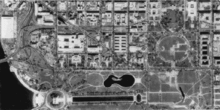- Digital orthophoto quadrangle
-
A digital orthophoto quadrangle[1] (DOQ) is aerial photography or satellite imagery that has been corrected so that its pixels are aligned with longitude and latitude lines, and have a narrowly defined region of coverage. This is a widely used format introduced by United States Geological Survey.[1] The correction technique is called image rectification and is a large part of photogrammetry.[2]
See also
References
- ^ a b "USGS GeoData Digital Orthophoto Quadrangles" (PDF). USGS Fact Sheet 057-01. U.S. Geological Survey. May 2001. http://edc2.usgs.gov/pubslists/factsheets/fs05701.pdf.
- ^ "Introduction to Photogrammetry". The Aerial Archive. Institute for Prehistory and Protohistory of the University of Vienna. http://www.univie.ac.at/Luftbildarchiv/wgv/intro.htm.
External links
- U.S. Geological Survey Mapping in the 20th Century: 1980’s - Digital Orthophoto Quadrangles
- Birthplace of the DOQ — USGS Western Region
Categories:- Geography
- Geographic information systems
- Geodesy
- Surveying
- Cartography
- United States Geological Survey
- Cartography stubs
- Photography stubs
Wikimedia Foundation. 2010.

